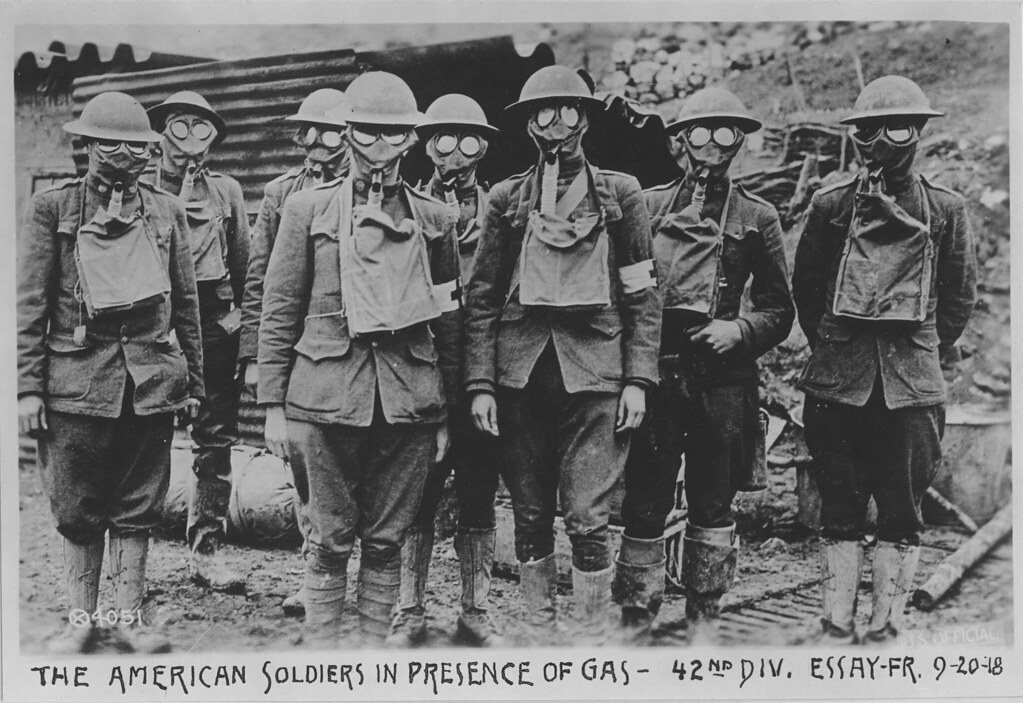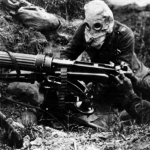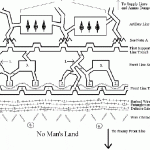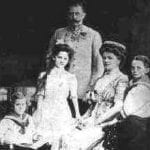In 1915, the Central Powers and Allies dug in their heels and tried desperately to break the stalemate of the war, still hoping for a short conflict on the scale of a few months. Poison gas was used for the first time. Germans experimented with flamethrowers and armored shields, while the French began using hand grenades. In April, Germans began the Second Battle of Ypres and used 168 tons of chlorine gas. On the Eastern Front, Austria launched three offensives against Russian forces in the Carpathians. All three failed miserably. As many as 100,000 Austrian soldiers froze to death. Further north, Russian forces began to retreat from Warsaw and Riga. In Poland, Russian forces adopted a “scorched earth policy.” They forced Poles and other residents of Poland and western Russia to burn their crops and abandon their homes. This created millions of refugees. In December, the remains of the Serbian Army, along with several hundred thousand civilians, fled through the freezing mountains of Montenegro and Albania to the coast. 200,000 died along the way (out of 700,000 initially). Finally, the Ottomans began the forced deportation of Armenians to Syria, which was actually a death march. It became known as the Armenian Genocide in which 1.5 million were slaughtered.
-
Western Front
-
Winter Offensives: Joffre wanted to push the Germans back and help prevent them from sending more troops to the East. So they launched a series of offensives in late 1914 and 1915
-
First Battle of Artois (17 Dec 1914 – 13 Jan 1915)
-
First Champagne Offensive (20 Dec 1914 – 17 March 1915). 93.000 French casualties and 46,000 German.
-
The Christmas Truce
-
Jan 31: Poison gas used for first time – it had little effect due to cold weather. In March, Germans experimented with flamethrowers and armored shields, while the French began using hand grenades.
-
March 10: British First Army (let by Sir Douglas Haig) attacked Germans at Neuve-Chappelle. His policy was “bite and hold,” which meant quickly taking a piece of the enemy’s line and forcing them to counterattack it, suffering many casualties.
-
-
Spring Offenses
-
April 17: The British launched an attack at Hill 60, in which they used mines to undermine the German position.
-
April 22: Germans began the Second Battle of Ypres and used 168 tons of chlorine gas. This time it had devastating consequences. The British used makeshift respirators, including cloths draped in urine. The Allies held the town. The battle lasted just over a month.
-
May 8: The British and French launched a combined offensive (first time) at the Second Battle of Artois. The battle lasted 6 weeks. The French lost 100,000 casualties, while the Germans lost 75,000.
-
-
In late September, the British and French launched offensives at Loos, Artois (Third Battle), and Champagne (Second Battle). The British used poison gas for the first time. The British and French initially took their objectives, but a stubborn German defense caused massive Allied casualties. Germans used phosgene gas (worse than chlorine). These ended the first week of November. Neither side gained anything.
-
On December 19, Sir John French was replaced as the BEF commander by Sir Douglas Haig.
-
-
Eastern Front
-
Austria launched three offensives against Russian forces in the Carpathians. All three failed miserably. As many as 100,000 Austrian soldiers froze to death.
-
Przemysl fell to the Russians on March 23. 126,000 prisoners and over 700 big guns fell to the Russians.
-
May 1: A combined German-Austrian army launched an offensive against the Russians at Gorlice and Tarnow. The Russians had to retreat, and they lost all the land they had gained since the start of the war. 30,000 Russian prisoners were taken. Austrian forces recaptured Przemysl on June 3 and Lvov on June 22.
-
Further north, Russian forces began to retreat from Warsaw and Riga. In Poland, Russian forces adopted a “scorched earth policy.” They forced Poles and other residents of Poland and western Russia to burn their crops and abandon their homes. This created millions of refugees.
-
Warsaw fell to the German Army on August 5. Soon after Ivangorod, Kovno, Novogeorgiev, Brest-Litovsk, Bialystock, and the Grodno fortress fell. 1.5 million Russian prisoners had been taken by the end of August. Soon after, Austrian and German forces linked up to form a single line.
-
On September 5, Tsar Nicolas removed the Grand Duke Nikolai from command and assumed personal command of the army.
-
On September 18, the Germans took Vilnius and drove its Russian defenders completely out of Poland and Galicia. Russia had lost 300 miles of territory. But the ground became muddy and the Russians improved their defenses. This stopped the German advance.
-
After Christmas, the Russian army launched major offensives in Bessarabia, Eastern Galicia, and also attacked in other places, including the Prippett Marshes. None of these attacks succeeded.
-
By the end of 1915, Russia had suffered 3.4 million casualties and there were 2 million Russians displaced by the war.
-
In January, 1916, Russia successfully attacked through the
-
-
The Balkans
-
In March, a typhus epidemic broke out, killing many Serbs and Austrians. The outbreak prevented any attacks on Serbia for a while.
-
On April 1, a force of Bulgarian Turks attacked Valandovo, in Macedonia (then part of Serbia). Serb forces repelled the invasion.
-
On September 6, Bulgaria joined the war on the side of the Central Powers. Along with Austria-Hungary and Germany, they invaded Serbia the next month (beginning October 6). Belgrade fell on October 9. (Bulgaria would end up sending 25% of its entire population to war…that’s the highest percentage.)
-
On November 5, Nis fell, giving the Central Powers a direct rail link from Berlin to Constantinople. At the end of the month, the Serbian army was defeated and forced to retreat.
-
In December, the remains of the Serbian Army, along with several hundred thousand civilians, fled through the freezing mountains of Montenegro and Albania to the coast. 200,000 died along the way (out of 700,000 initially). Allied naval forces evacuated them from the Albanian coast to Corfu.
-
French and British forces tried to help the Serbian army but were pushed by the Bulgarian army out of Macedonia into Greece. They established a base at Salonika (over the objections of the Greek government, which was neutral).
-
In January 2016, the Austrian army invaded Montenegro. The government surrendered, but the army fled into Albania. The Austrians pursued them.
-
-
Southern Front
-
February: Turkish attacked British forces in Egypt in an attempt to take the Suez Canal. They were soundly defeated.
-
Turkey began the forced deportation of Armenians.
-
British troops defend Basra and advance up the Tigris Valley toward Baghdad. In December, they became trapped at Kut-al-Amara., which the Turks put under siege.
-
The next month, a rescue operation tried but failed to relieve them. Repeated attempts to rescue them would also fail, and the British force would eventually surrender in April 1916.
-
May 23: Italy joins the war on the side of the Allies and attacked Austria-Hungary at the Isonzo River. For the next few months, they fought multiple battles there but made no gains. The fighting finally ended on December 10 due to winter weather.
-
In the summer, Italy raided the Adriatic coast in several places.
-
-
Sea & Air
-
December 14, 1914: German ships bombarded the cities of Scarborough, Whitley, and Hartleypool. This killed several civilians (first time since 1690!), but it increased popular British hatred for the Germans.
-
Feb: Germans begin Unrestricted Submarine Warfare
-
Mar: British start a sea blockade of Germany. Later they mine the North Sea.
-
May 7: A German U-boat sinks the Lusitania (1200 people, including 120 Americans are killed).
-
The Dutch inventor Anthony Fokker invents (for the Germans) developed interrupter gear, which led to German domination of the skies (the “Fokker Scourge”).
-
On April 1916 the Germans began a policy of Unrestricted Submarine Warfare.
-
This article is part of our larger selection of posts about World War One. To learn more, click here for our comprehensive guide to World War One.
Cite This Article
"WW1 Gas Attacks: When Poison Was Released in 1915" History on the Net© 2000-2024, Salem Media.
July 27, 2024 <https://www.historyonthenet.com/ww1-gas-attacks-when-poison-was-released-in-1915>
More Citation Information.









